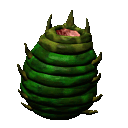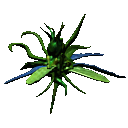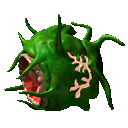www.pardus.at
| Overview | Index |
| Humanoids | Drones | Non-Sentient Life | Sentient Life |
| Biodegraders | Flora | Parasites | Serpents |
| Space Dragons | Swarms | Additional Sentient Life |
Flora |
| Sarracenia | |||||
Disposition: Predatory  Rarity: Common Region: Universal, not in Pardus Cluster |
The first stage of the Ceylacennia's evolution, Sarracenia are the most vulnerable to the toils of space. Sustained in part by the various elements found in Nebula clouds, these hapless pods spend their lives suspended in the red mists. Unable to propel themselves, they become slaves to the natural drift of the Nebula gasses, often times withering away to nothing in remote regions of space when denied the light of nearby stars for extended periods of time. Fooling their prey with pleasant smelling secretions, Sarracenias lure their victims in for the kill and thus survive in even the most desolate areas of the universe if life so demands of them. | ||||
| Drosera | |||||
Disposition: Predatory  Rarity: Common Region: Pardus Cluster, West and East Pardus Rim |
The proverbial thorn in any space traveler's paw is undoubtedly the bothersome Drosera. These insectoid looking creatures are in truth flora with long, silky vines that are often mistaken for antennae, legs, or other appendages. Using these vines as arms to snare their prey and anesthetizing them with venomous barbs, used also to deter potential predators, they then proceed to feed on the blood of their victim much like a spider or mosquito. | ||||
| Xalgucennia | |||||
Disposition: Predatory  Rarity: Rare Region: Pardus Core |
The second stage of the Ceylacennia's evolution, the Xalgucennia at last breaks free from the bonds of immobility, able to exist for short periods outside the Nebula clouds which have housed it from its birth. Choosing to either migrate towards sources of light to fuel their photosynthesis, or away to lead a more predatory lifestyle, the Xalgucennia, like the Sarracennia, can smell sweet and alluring, but has a ferocity unexpected and rarely seen in celluloid life forms. | ||||
| Ceylacennia | |||||
Disposition: Predatory  Rarity: Rare Region: Pardus Core |
Third and final stage of its evolution, the Ceylacennia is by far the most fearsome of the three Cennias. No longer dependant on the light emitted by stars, Xalgucennia find that photosynthesis alone can no longer satiate their ravenous hunger and travel off in search of food, becoming more aggressive in their hunt as the universe grows ever more crowded and the battle for survival grows more and more competitive. | ||||
| Preywinder | |||||
Disposition: Aggressive  - Predatory - Predatory  Rarity: Rare Region: East Pardus Rim, Split Cluster, Pardus Core |
It was once believed that the Preywinder was just a harmless, overgrown flower, but closer observation shows that it takes on the traits of Earth's Venus Fly Trap and is actually quite dangerous. Its serene beauty lures prey, only to snare its victim in a fatal embrace when it gets too close. During the Preywinder's mating season, it releases clouds of pheromones to attract a mate. However, most of the time, it just attracts an over-confident and under-skilled pilot. | ||||
| < Biodegraders | | Up | | Parasites > |
Last modification on this page: 2009-12-27





